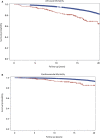Mortality in Patients With Right Bundle-Branch Block in the Absence of Cardiovascular Disease
- PMID: 32924743
- PMCID: PMC7792408
- DOI: 10.1161/JAHA.120.017430
Mortality in Patients With Right Bundle-Branch Block in the Absence of Cardiovascular Disease
Abstract
Background Right bundle-branch block (RBBB) occurs in 0.2% to 1.3% of people and is considered a benign finding. However, some studies have suggested increased risk of cardiovascular morbidity and mortality. We sought to evaluate risk attributable to incidental RBBB in patients without prior diagnosis of cardiovascular disease (CVD). Methods and Results We reviewed the Mayo Clinic Integrated Stress Center database for exercise stress tests performed from 1993 to 2010. Patients with no known CVD-defined as absence of coronary disease, structural heart disease, heart failure, or cerebrovascular disease-were selected. Only Minnesota residents were included, all of whom had full mortality and outcomes data. There were 22 806 patients without CVD identified; 220 of whom (0.96%) had RBBB, followed for 6 to 23 years (mean 12.4±5.1). There were 8256 women (36.2%), mean age was 52±11 years; and 1837 deaths (8.05%), including 645 cardiovascular-related deaths (2.83%), occurred over follow-up. RBBB was predictive of all-cause (hazard ratio [HR], 1.5; 95% CI, 1.1-2.0; P=0.0058) and cardiovascular-related mortality (HR,1.7; 95% CI, 1.1-2.8; P=0.0178) after adjusting for age, sex, diabetes mellitus, hypertension, obesity, current and past history of smoking, and use of a heart rate-lowering drug. Patients with RBBB exhibited more hypertension (34.1% versus 23.7%, P<0.0003), decreased functional aerobic capacity (82±25% versus 90±24%; P<0.0001), slower heart rate recovery (13.5±11.5 versus 17.1±9.4 bpm; P<0.0001), and more dyspnea (28.2% versus 22.4%; P<0.0399) on exercise testing. Conclusions Patients with RBBB without CVD have increased risk of all-cause mortality, cardiovascular-related mortality, and lower exercise tolerance. These data suggest RBBB may be a marker of early CVD and merit further prospective evaluation.
Keywords: ECG; mortality; right bundle‐branch block; stress testing.
Conflict of interest statement
None.
Figures



Comment in
-
What Should Be Done With the Asymptomatic Patient With Right Bundle Branch Block?J Am Heart Assoc. 2020 Oct 20;9(19):e018987. doi: 10.1161/JAHA.120.018987. Epub 2020 Sep 14. J Am Heart Assoc. 2020. PMID: 32924752 Free PMC article. No abstract available.
References
-
- Stein R, Nguyen P, Abella J, Olson H, Myers J, Froelicher V. Prevalence and prognostic significance of exercise‐induced right bundle branch block. Am J Cardiol. 2010;105:677–680. - PubMed
-
- Surawicz B, Childers R, Deal BJ, Gettes LS, Bailey JJ, Gorgels A, Hancock EW, Josephson M, Kligfield P, Kors JA, et al. AHA/ACCF/HRS recommendations for the standardization and interpretation of the electrocardiogram: part III: intraventricular conduction disturbances: a scientific statement from the American Heart Association Electrocardiography and Arrhythmias Committee, Council on Clinical Cardiology; the American College of Cardiology Foundation; and the Heart Rhythm Society. Endorsed by the International Society for Computerized Electrocardiology. Circulation. 2009;119:e235–e240. - PubMed
-
- Nelson AJ, Wong GR, Roberts‐Thomson R, Parvar SL. Massive pulmonary embolism with acute cor pulmonale. Postgrad Med J. 2016;92:487–488. - PubMed
-
- Reisinger J, Dubrey SW, Lavalley M, Skinner M, Falk RH. Electrophysiologic abnormalities in AL (primary) amyloidosis with cardiac involvement. J Am Coll Cardiol. 1997;30:1046–1051. - PubMed
MeSH terms
LinkOut - more resources
Full Text Sources
Miscellaneous

